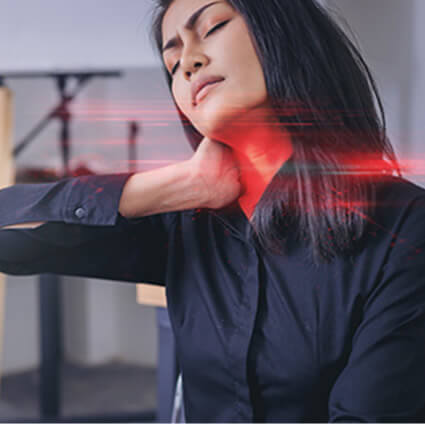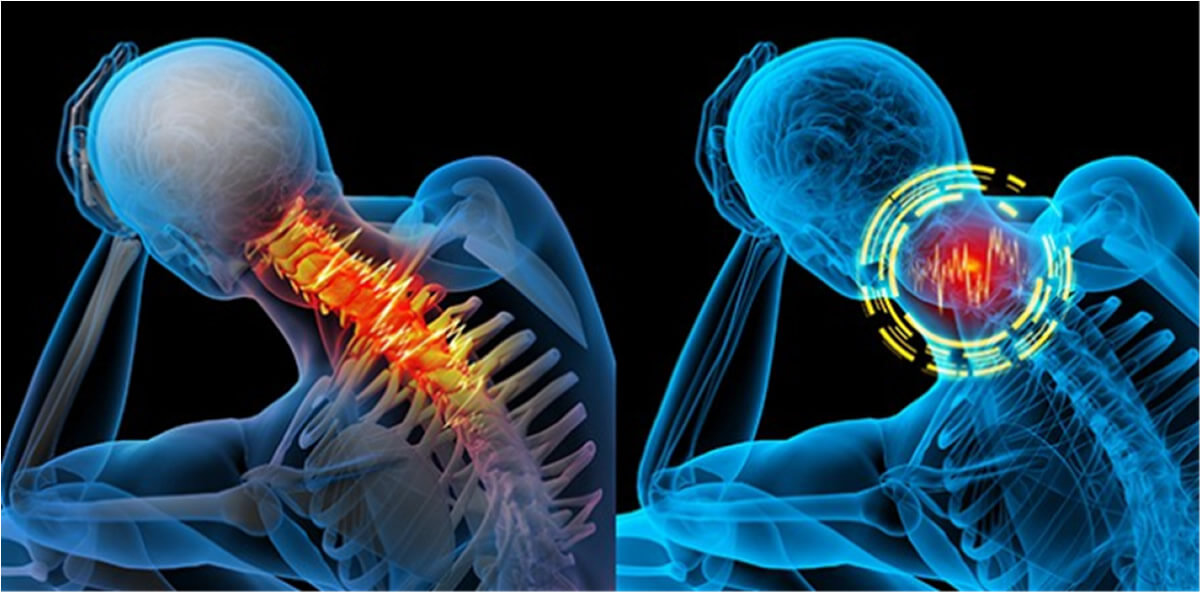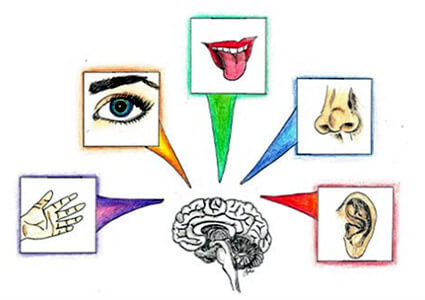Neck Pain Treatment in London
 Neck pain is a very common issue worldwide, with up to half of all people around the world experiencing it at some point each year. For some people, one big problem with neck pain is that it just keeps coming back or becomes chronic and may even increase their risk of suffering from a fall.
Neck pain is a very common issue worldwide, with up to half of all people around the world experiencing it at some point each year. For some people, one big problem with neck pain is that it just keeps coming back or becomes chronic and may even increase their risk of suffering from a fall.
The Role of Sensorimotor Function
Your brain relies on sensory information from the muscles and joints around your spine to control balance, posture, and movement and to make sure you’re moving properly.
When your brain takes sensory information and uses it to help guide movements and control muscles, we call this sensorimotor function. One study looked at whether neck pain impacts proper sensorimotor function in older people.
In this study, the researchers ran tests of sensorimotor function, like how well the study participants controlled the movement of their eyes and how good their balance was, and they took into account their age and other conditions that they suffered from. They found that older people with neck pain were worse than those without neck pain at most of the tests that they performed. For example, people with neck pain couldn’t control their eyes as well, and their balance wasn’t as good as people who had no pain.


Implications for Balance and Fall Risk
The researchers suggested that people with neck pain had poor communication between their neck and their brain, which meant that they weren’t as good at controlling their balance and other types of sensorimotor function. Remember that your brain uses sensory information from your muscles and joints around your spine to help control your balance and posture and to make sure you’re moving properly.
So, if that information from your spine isn’t very good, your brain will struggle to control what’s going on in your body. The scientists who did this study were saying that the altered information from the neck of these older people who had neck pain was disturbing their brains’ ability to make sense of other sensory information. This, in turn, potentially affected their balance and increased their risk of falling.
Chiropractic Studies
Many research studies have shown that chiropractic care is an effective option for people with neck pain and safe compared to other common treatments.
But there’s more to chiropractic care than just helping people with their pain. Researchers from New Zealand have published studies over many years that suggest that chiropractic care improves the accuracy of the communication between your spine and brain, which makes it easier for your brain to accurately tell what is going on in and around your body. And that the spinal dysfunction does not need to be so bad that you are in pain for your brain to be disturbed. A course of precise spinal adjustments helps enhance your brain’s ability to accurately interpret and respond to sensory information.

Chiropractic Care for Older Adults
Scientists have even shown that chiropractic care for older adults improves specific forms of sensorimotor function that are very relevant to fall risk. In one study, they looked at the effects of 12 weeks of chiropractic care on sensorimotor function in older adults.
The types of sensorimotor function they looked at were important measures of brain/body communication related to balance and fall risk. What they found was that chiropractic care in these older adults improved how accurately their brains knew what their ankle joint was doing, even when their eyes were closed.
They found that the older adults could take a significantly faster step after receiving chiropractic care and it also helped their brains to process information from their eyes and ears at the same time. In this same study, they also showed that not only did the older adults who were receiving chiropractic care function better, but they felt better, too.
Optimising Brain-Body Communication
Although chiropractic care does help people with neck pain, it has so much more to offer, even if you don’t have neck pain. Chiropractic care is about improving the communication between your brain and body so you can function at your optimal potential. So, whether you suffer from neck pain or have loved ones who do, or just want to have a tune-up of your brain/body communication, chiropractic care can help.
Connect with us to schedule an appointment and tune up your spine, ensuring optimal function and well-being.
CONTACT US
References
1. Hoy D, March L, Woolf A, et al. The global burden of neck pain: estimates from the global burden of disease 2010 study. Ann Rheum Dis 2014;73(7):1309-15.
2. Cote P, van der Velde G, Cassidy JD, et al. The burden and determinants of neck pain in workers: results of the Bone and Joint Decade 2000-2010 Task Force on Neck Pain and Its Associated Disorders. Spine (Phila Pa 1976) 2008;33(4 Suppl):S60-74.
3. Fejer R, Kyvik KO, Hartvigsen J. The prevalence of neck pain in the world population: a systematic critical review of the literature. Eur Spine J 2006;15(6):834-48.
4. Bussieres AE, Stewart G, Al-Zoubi F, et al. The Treatment of Neck Pain-Associated Disorders and Whiplash-Associated Disorders: A Clinical Practice Guideline. J Manipulative Physiol Ther 2016;39(8):523-64.e27.
5. Cote P, Wong JJ, Sutton D, et al. Management of neck pain and associated disorders: A clinical practice guideline from the Ontario Protocol for Traffic Injury Management (OPTIMa) Collaboration. Eur Spine J 2016;25(7):2000-22.
6. Bryans R, Decina P, Descarreaux M, et al. Evidence-based guidelines for the chiropractic treatment of adults with neck pain. J Manipulative Physiol Ther 2014;37(1):42-63.
7. Uthaikhup S, Jull G, Sungkarat S, et al. The influence of neck pain on sensorimotor function in the elderly. Arch Gerontol Geriatr 2012;55(3):667-72.
8. Abbruzzese G, Berardelli A. Sensorimotor integration in movement disorders. Movement Disorders 2003;18(3):231-40.
9. Brumagne S, Cordo P, Lysens R, et al. The Role of Paraspinal Muscle Spindles in Lumbosacral Position Sense in Individuals With and Without Low Back Pain. 2000;25(8):989-94.
10. Haavik H, Murphy B. The role of spinal manipulation in addressing disordered sensorimotor integration and altered motor control. J Electromyogr Kinesiol 2012;22(5):768-76.
11. Haavik H, Murphy B. Subclinical neck pain and the effects of cervical manipulation on elbow joint position sense. J Manipulative Physiol Ther 2011;34(2):88-97.
12. Lackner JR, DiZio P. Vestibular, Proprioceptive, and Haptic Contributions to Spatial Orientation. Annual Review of Psychology 2004;56(1):115-47.
13. Pickar JG, Wheeler JD. Response of muscle proprioceptors to spinal manipulative-like loads in the anesthetized cat. Journal of Manipulative and Physiological Therapeutics 2001;24(1):2-11.
14. Wong JJ, Shearer HM, Mior S, et al. Are manual therapies, passive physical modalities, or acupuncture effective for the management of patients with whiplash-associated disorders or neck pain and associated disorders? An update of the Bone and Joint Decade Task Force on Neck Pain and Its Associated Disorders by the OPTIMa collaboration. Spine J 2016;16(12):1598-630.
15. Leininger B, McDonough C, Evans R, et al. Cost-effectiveness of spinal manipulative therapy, supervised exercise, and home exercise for older adults with chronic neck pain. Spine J 2016;16(11):1292-304.
16. Michaleff ZA, Lin CW, Maher CG, et al. Spinal manipulation epidemiology: systematic review of cost effectiveness studies. J Electromyogr Kinesiol 2012;22(5):655-62.
17. van der Velde G, Yu H, Paulden M, et al. Which interventions are cost-effective for the management of whiplash-associated and neck pain-associated disorders? A systematic review of the health economic literature by the Ontario Protocol for Traffic Injury Management (OPTIMa) Collaboration. Spine J 2016;16(12):1582-97.
18. Jevne J, Hartvigsen J, Christensen HW. Compensation claims for chiropractic in Denmark and Norway 2004-2012. Chiropr Man Therap 2014;22(1):37.
19. Holt KR, Haavik H, Lee AC, et al. Effectiveness of Chiropractic Care to Improve Sensorimotor Function Associated With Falls Risk in Older People: A Randomized Controlled Trial. J Manipulative Physiol Ther 2016.
20. Gross A, Miller J, D’Sylva J, et al. Manipulation or mobilisation for neck pain: a Cochrane Review. Man Ther 2010;15(4):315-33.
21. Hawk C, Khorsan R, Lisi AJ, et al. Chiropractic Care for Nonmusculoskeletal Conditions: A Systematic Review with Implications for Whole Systems Research. J Altern Complement Med 2007;13(5):491-512.
22. The Rubicon Group. Definition and Position Statement on the Chiropractic Subluxation. [Online] Available at: http://www.therubicongroup.org/#/policies/: The Rubicon Group, 2017:4.
Acknowledgments
• Dr. Heidi Haavik – BSc(Physiol) BSc(Chiro) PhD
• Dr. Kelly Holt – BSc, BSc(Chiro), PGDipHSc, PhD
• Dr. Jenna Duehr – BChiro, BHSC (Nursing), MHSc

